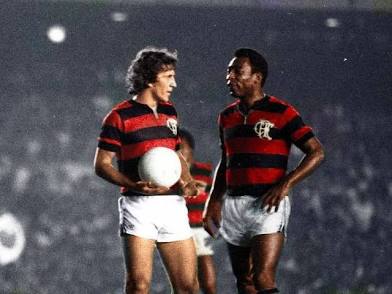Legends considered the best of all time (19th century – present)
This is the Part 3 of ”The greatest players in history” series by 90soccer. 16 more players to follow in the list below as a sequel to the Part 2. The following players should be considered in the same bracket with the ones previously presented in Part 2.
Someone could say that the players of this list are rather ”outsiders” compared to megastars like Messi, Maradona and Pele. Maybe. But, they were definitely game changers in their playing years. True legends, and real winners like Zico of Brazil, Platini of France or Gerd Muller of Germany.
The criteria for the research were:
- Players who are or were considered as the best ever at one or another point, before or after retirement
- Two to three endorsements by experts, players or famous personalities who referred to them as ”the greatest of all time” – not just one of the best and not just recently, but throughout history
- Players who were condisered the greatest of their generation
- Attention from press and media and impact on soccer
- Performances for club and national team, including youth years, technical abilities, leadership skills and individual accolades
Below are 16 players considered to be the greatest of all time, and several endorsers who named them as No1 in history. Note that the order is alphabetical, starting from number 31.
#31. Baggio (Italy)
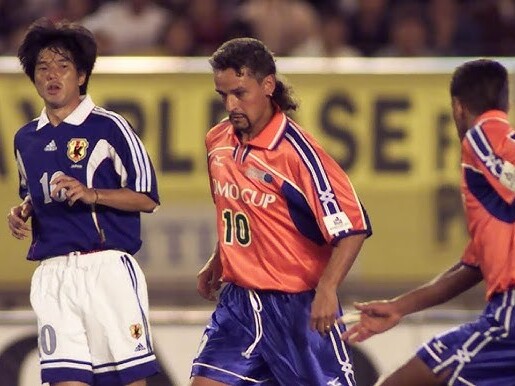
- Name: Roberto Baggio
- Born: 18 February 1967
- Position: Attacking Midfielder, Forward, Second Striker
- Jersey numbers: #9, #10, #15, #16, #18
- Youth career: Caldogno, Vicenza
- Pro career (1982-2004): Vicenza, Fiorentina, Juventus, AC Milan, Bologna, Inter Milan, Brescia
- National team: Italy
For many Italians, Baggio was not just a national hero who singlehandedly took Italy to the 1994 World Cup final, but a ”Giuseppe Meazza revived”.
“I’ll Divin Codino” (“The Divine Ponytail”) is considered as one of the finest players to ever play the game. Even without using his (injured) left foot. In the summer of 1990, Florence was an upset city. Fiorentina’s decision to sell him to Gianni Agnelli’s Juventus caused riots. Baggio didn’t want to leave Fiorentina, but he agreed to move to Torino. The most expensive transfer in the history of soccer had been completed and he was bound for life with Juventus. A contract with Juve until he retires.
But it was not meant to be. Marcelo Lippi was planning to replace him with starlet Alessandro Del Piero who broke out during the 1994/95 season and Baggio was on his way out. Summer of 1995 and Japanese club Yomiuri Verdy came close to sign him, Barcelona was also interested, but Baggio signed for Silvio Berlusconi’s AC Milan. Despite being a lifelong Inter Milan fan. A dream realised three years later, in 1998. Baggio won two Serie A titles, a Coppa Italia, and a UEFA Cup, playing for seven different Italian clubs during his career (Vicenza, Fiorentina, Juventus, AC Milan, Bologna, Inter Milan, and Brescia).
Described as a “fantasista”, “trequartista”, or “rifinitore” throughout his career in the Italian media, due to his role on the pitch and creative playing style, Baggio was a world-class playmaker with an eye for goal. He was renowned for his vision, creativity, ability to read the game, crossing accuracy, and passing ability, which made him an excellent assist provider. Michel Platini had described his position as a “number 9 and a half”.
He was extremely popular in Japan and in 2000 he featured in the Japanese Jomo Cup as a special guest star. Juventus owner Gianni Agnelli had said about Baggio that he considered him the best player of all time.
Endorsers: Gianni Agnelli, Fabrizio Ravanelli
#32. Bican (Czechia)
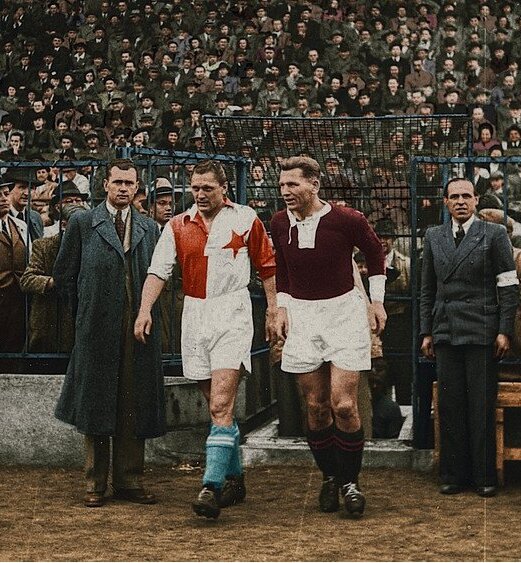
- Name: Josef Bican
- Born: 25 September 1913, died 12 December 2001
- Position: Centre-Forward
- Jersey numbers: #7, #10
- Youth career: Hertha Vienna, Schustek, Farbenlutzouth
- Pro career (1931-1957): Farbenlutz, Rapid Vienna Amateur, Rapid Vienna, Admira Vienna, Slavia Prague, FC Vítkovice, FC Hradec Králové, Dynamo Prague, Slovan Liberec, Spartak Brno ZJŠ
- National team: Austria, Czechoslovakia, Bohemia & Moravia
Is Cristiano Ronaldo the highest goal scorer in history of soccer? Probably not. According to Bican’s biography, the Austrian Czech scored a staggering 5,000 goals in total! Four years ago the Czech F.A claimed that Josef Bican in-fact scored 821 official goals. Bican averaged 1.52 goals per game at club level and also starred for Austria.and Czechoslovakia national teams.
In 1925, at the age of twelve, he was already playing in the youth set-up of Hertha Vienna, his father’s beloved club, and also where his idol, Matthias Sindelar had begun his career from. He then moved to Rapid Vienna. In his first youth game for Rapid Wien, aged 17, he scored seven goals, and so he was promoted to the Amateur side, which was typically for 18- and 19-year-olds.
In 1933, Bican embarked on his international career with Austria, a dominant force in European soccer then. The following year, he competed at the 1934 FIFA World Cup in Italy, where the Wunderteam lost in the semi-finals to the hosts. After a few years with the club he signed for Slavia Prague (Juventus was also interested) and in 1938 he led them to a Mitropa Cup triumph, beating Hungary’s Ferencvaros in the final. Bican became Slavia’s top goal scorer in no time, and his status reached the heights of a living legend of the club.
After the Second World War, foreign clubs came looking for Bican again, including Juventus (a decade after first showing an interest). But, there were concerns that Italy might follow other parts of Europe and turn to Communism. The irony of it all is that in 1948, that was exactly what happened in Czechoslavakia. Thus, Bican never got to play in Serie A and Juventus.
In 2000, IFFHS awarded Bican the “Golden Ball” in recognition of his status as the greatest goalscorer of the 20th century, the only player who won a topscorer award in the top flight 12 times! .
Bican is considered by RSSSF as the second-most prolific goalscorer in history behind Erwin Helmchen, with over 950 goals scored in 624 official matches (or more than 1,812 goals overall in plus 1,038 matches). He scored 591 goals in 301 official games for Slavia Prague across his 11-year career at the club and remains its greatest legend.
It is really absurd why a goalscoring machine like Bican does not get the recognition he deserves when it comes to rankings of the game’s greats.
Endorsers: Laszlo Kubala (1973), Michael Patrick (expert)
#33. Bloomer (England)
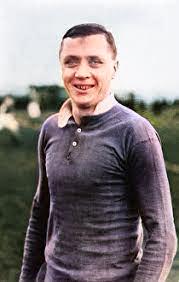
- Name: Steve Bloomer
- Born: 20 January 1874, died 16 April 1938
- Position: Centre-Forward
- Jersey numbers: – (no numbers before 1911)
- Youth career: St. Chad’s Juniors, Derby Swifts
- Pro career (1891-1914): Derby Midland, Derby County, Middlesbrough, Derby County
- National team: England
A Derby County legend. A pioneer of British soccer. The anthem “Steve Bloomer’s Watchin'” is played at every Derby home game and there is a bust of him at the Pride Park Stadium.
Bloomer was a quick-thinking forward able to shoot powerfully and accurately with either foot. He was strong with great speed, playing until the age of 40. In 535 First Division games he scored 314 goals and, after Jimmy Greaves, he is the second-highest all-time goalscorer in the top-flight of English soccer. He also scored 28 goals in 23 appearances for England and helped Derby County win the Second Division title in 1911–12, and finish second in the First Division in 1895–96. Bloomer also played on the losing side in four FA Cup semi-finals and three FA Cup finals (1898, 1899 and 1903).
Bloomer was considered as the best ever for many years after his retirement. Apart from soccer he also played baseball for Derby Baseball Club and helped them become British champions three times in the 1890s.
Endorsers: Morgan T. Roberts (1908), James Bagshaw (1952)
#34. Charles (Wales)
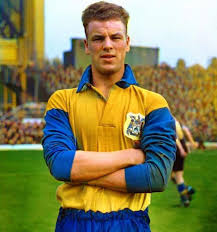
- Name: John Charles
- Born: 27 December 1931, died 21 February 2004
- Position: Centre-Forward, Centre-Back
- Jersey numbers: #4, #5, #7, #8, #9, #11
- Youth career: Swansea Town, Leeds United
- Pro career (1949-1974): Leeds United, Juventus, Leeds United, Roma, Cardiff City, Hereford United, Merthyr Tydfil
- National team: Wales
The most complete player ever: he could play as a top-class centre back the same way he could play as a clinical centre forward. During his career he used six different shirts numbers out of possible ten (from 2 to 11), a rare fact for any player. Charles has been rated by many as the greatest all-round soccer player ever.
As a striker, he was renowned for being a prolific goalscorer, as he was capable of scoring with either foot, courtesy of his powerful and accurate shot; due to his height, physique, and strength, as well as his heading power and accuracy, he also excelled in the air, which made him an aerial goal threat. Despite his big size, he was also a fast player, with good technical skills and passing ability, which allowed him both to score and create goals.
In the foreword for Charles’ autobiography, Sir Bobby Robson described him as “incomparable” and classed him among the all-time greats such as Pelé, Diego Maradona and George Best. He added: ‘’John wasn’t only one of the greatest footballers who ever lived. He was one of the greatest men ever to play the game’’, noting that Charles is the only great to be world class in two very different positions. John Charles was Wales’ greatest ever player.
He played in 2 Coppa Italia finals with Juventus and scored in both of them. Winning finals, of course. In addition to his skills, he was also known for his fair-play behaviour on the pitch, which along with his stature, earned him the nickname Il Gigante Buono (The Gentle Giant) during his years in Italy.
According to Welsh manager John Toschack there has never been any player in history greater and more complete than John Charles.
Endorsers: John Toschack, Alex McInnes (1965), Bobby Robson (alongside Pele, Maradona and Best)
#35. Charlton (England)
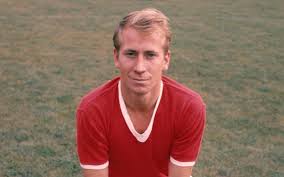
- Name: Sir Bobby Charlton
- Born: 11 October 1937, died 21 October 2023
- Position: Attacking Midfielder, Left Winger, Centre-Forward
- Jersey numbers: #8, #9, #10, #11, #12
- Youth career: East Northumberland Schools, Manchester United
- Pro career (1956-1980): Manchester United, Preston North End, Waterford, Newcastle KB United, Perth Azzurri, Blacktown City
- National team: England
There is no other player that embodied the values of Manchester United better than Sir Bobby Charlton. Having survived the trauma of the Munich Air Disaster when aged just 20, he played as if every game was for his 23 fallen colleagues, recovering from his injuries to reach the pinnacle for both club and country.
Charlton played alongside elder brother Jack against West Germany at Wembley in 1966 as one of only 11 England players to win the World Cup and captained Manchester United to the game’s major honours, including the European Cup in 1968, scoring twice. In his prime, Charlton was considered to be one of the greatest players in the world, being able to dictate a game with his accurate passing, and possessing a powerful shot with either foot, often scoring goals from a distance. He also stood out for his stamina, mentality, leadership and modesty, never arguing with referees or opponents.
In a 17-year playing career with the Reds, he played 758 games and scored 249 goals – both of which were longstanding records until, respectively, Ryan Giggs in 2008 and Wayne Rooney in 2017 surpassed his feats. Charlton was one of nine players to have won the World Cup and the European Cup and the Ballon d’or. The best ever according to German full back Manfred Kaltz and journalist Simon Barnes.
Endorsers: Simon Barnes (2017), Manfred Kaltz (1979)
#36. Edwards (England)
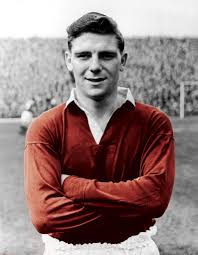
- Name: Duncan Edwards
- Born: 1 October 1936, died 21 February 1958
- Position: Left Half, Defensive Midfielder
- Jersey numbers: #4, #5, #6
- Youth career: Manchester United
- Pro career (1953-1958): Manchester United
- National team: England
Renowned for playing soccer with teammates several years his senior, Edwards made his first appearance for England Schoolboys at just 13. The precocious and powerful teenager began to attract the attention of a number of First Division sides in English soccer, and in 1952, he was signed by Manchester United. After six months, he made his first team debut and from then on, the sixteen-year-old became a first team favourite, claiming the number 5 shirt.
He was a defensive midfielder who broke up opposition attacks only to surge forward, and he became the youngest post-war England international in 1955 at 18 years and 183 days. In a single season he played over 100 matches, making appearances for his club, his country and his national service. regiment. Although he is primarily remembered as a defensive midfielder, Edwards is said to have been able to operate in any outfield position. His versatility was such that on one occasion he started the match playing as an emergency striker in place of one injured player before being switched to central defence in place of another.
His greatest assets were his physical strength and his level of authority on the pitch, which was said to be remarkable for such a young player, and he was particularly noted for his high level of stamina. Edwards was one of eight players who died as a result of the Munich air disaster. He survived initially but succumbed to his injuries in hospital two weeks later. He was only 21. Many of his contemporaries have described him as one of the best, if not the best, players with whom they had played.
Fun fact? Although Edwards owned a car, he could not drive and would cycle to and from Old Trafford on his Raleigh bike!
Endorsers: Tommy Docherty, David Gardner (2021), Matt Busby, Daniel Taylor (2015)
#37. Laudrup (Denmark)
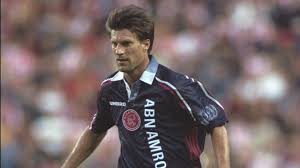
- Name: Michael Laudrup
- Born: 15 June 1964
- Position: Attacking Midfielder
- Jersey numbers: #5, #6, #9, #10, #11, #14, #15
- Youth career: Vanløse, Brøndby, Kjøbenhavns Boldklub
- Pro career (1981-1998): Kjøbenhavns Boldklub, Brøndby, Lazio, Juventus, Barcelona, Real Madrid, Vissel Kobe, Ajax
- National team: Denmark
Ask Iniesta who he considers the best player of all time. His childhood idol, Michael Laudrup.
He could have been a European champion with Denmark in 1992, but he opted to go on holiday. That was Laudrup. Unpredictable, uncompromised. He was known for his composure, passing, vision, technical skills, ball control, and dribbling ability, and won league titles with Ajax, Barcelona, Real Madrid and Juventus. Laudrup was recognized as one of the best soccer players of his generation, and became a key member of Johan Cruyff’s “Dream Team”, Barcelona.
Laudrup was a player who wouldn’t hesitate to make surprise moves in his career: he left all conquering Barcelona to go to then second best Real Madriid, then signed for Vissel Kobe in Japan though the “merenjes” wanted him to stay and after his stint in the J-League he returned to Europe for Dutch powerhouse Ajax. And he retired when Ajax wanted him to sign a new contract. Following his 1998 retirement, Laudrup sometimes turned out to play for Lyngby’s Old Boys team in his spare time and in 2002 he was ready with his brother Brian, to come out of retirement to save Lungby from relegation.
He captained Denmark for a total of 28 matches, including the victorious 1995 Confederations Cup. He also played alongside his brother Brian in the Denmark team that reached the quarter-finals of the 1998 World Cup, and retired as an active player after the tournament and Denmark’s number 10.
Endorsers: Iniesta, Thierry Henry
#38. Law (Scotland)
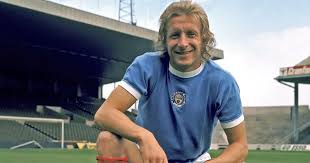
- Name: Denis Law
- Born: 24 February 1940, died 17 January 2025
- Position: Centre-Forward
- Jersey numbers: #4, #7, #8, #9, #10, #11, #12
- Youth career: Huddersfield Town
- Pro career (1956-1974): Huddersfield Town, Manchester City, Torino, Manchester United, Manchester City
- National team: Scotland
Nicnamed as “The King”. One of the best players ever in the history of British soccer and the first Scottish to win the Ballon d’or, by the France Football magazine.
After an impressive start with Huddersfield, Law signed for Manchester City and within a year Italian club Torino bought him for £110,000: a record fee for a transfer involving a British player. Law signed for crosstown rivals Manchester United in 1962, setting another British record transfer fee of £115,000, breaking his own one. Law could have stayed in Italy, but he preferred to return to England. For the next 11 years he would become a Manchester United legend, before returning to City in 1973 to end his career.
Law played for Scotland a total of 55 times and jointly holds the Scottish international record goal tally with 30 goals. He also holds a Manchester United record for scoring 46 competitive goals in a single season. In 1964 he won the Ballon d’or, an unheard of achievement nowadays for a Scottish player.
Law, for many, was greater than Bobby Charlton or George Best during their time with the Red Devils.
Endorsers: J. McGeaghy (1965), Sandy Jackson (1965)
#39. Meredith (Wales)
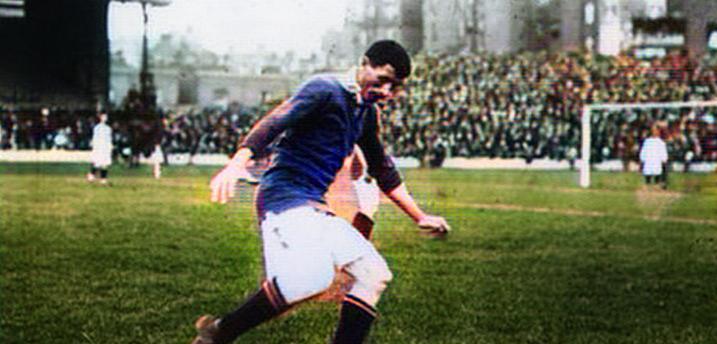
- Name: Billy Meredith
- Born: 30 July 1874, died 19 April 1958
- Position: Outside Forward
- Jersey number: #7
- Youth career: Black Park
- Pro career (1890-1924): Chirk, Northwich Victoria, Wrexham, Chirk, Manchester City, Manchester United, Manchester City
- National team: Wales
One of the early superstars of the sport. Billy Meredith, a Welsh ”folk hero”. After 4 seasons in Welsh league he signed for Manchester City and became its legend. Playing there for 12 years in total until the age of 50!
An incredible fact about Meredith is that he also played for Manchester United, not for a few years: one and a half decade (1906-1921)! That iconic number 7 worn by Best, Beckham, Cantona, Cristiano Ronaldo at United, had been worn by legendary Meredith first.
Meredith’s favoured position was outside right, and he was known for his dribbling, passing, crossing and shooting. He was a dedicated and extremely fit professional, and his habit of chewing on a toothpick during games made him instantly recognisable. Meredith managed to avoid injuries throughout his 34-year long career despite the extremely physical nature of the game during that period. This was due in part to his extraordinary balance and agility, which allowed him to avoid clumsy challenges, and the toughness he had built up from spending his adolescence working in the mines.
He won each domestic trophy in the England and gained 48 caps for Wales helping his country win two British Home Championship titles. Not an easy task back then, with England and Scotland the hot favourites every year. He was named as the best player ever by Jas Blair and Grenville Morris.
Endorsers: Jas Blair (1920), Grenville Morris (1930)
#40. Müller (Germany)
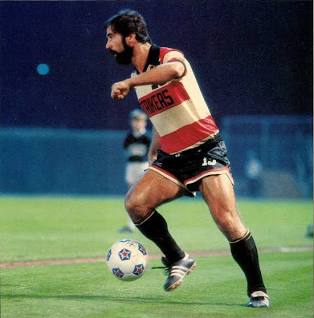
- Name: Gerd Müller
- Born: 3 November 1945, died 15 August 2021
- Position: Centre-Forward
- Jersey numbers: #9, #13, #15
- Youth career: TSV 1861 Nördlingen
- Pro career (1963-1981): TSV 1861 Nördlingen, Bayern Munich, Fort Lauderdale Strikers
- National team: West Germany
The right man at the right time. What a prolific striker, especially in and around the six-yard box! According to “Almanaque dos Artilheiros” he is the second goalscorer of all time with 1461 goals, only 7 short of the list’s topper, Josef Bican. Muller is widely regarded as one of the greatest goalscorers and players in the history of soccer, and one of the nine to have won the FIFA World Cup, the UEFA Champions League and the Ballon d’Or.
He signed for Bayern Munich in 1963, aged 18. The Bavarians were not a successful club back then, still in the Regionalliga Süd (Regional League South), which was one level below the Bundesliga. With Muller’s goals Bayern clinched promotion to Bundesliga straight away. Müller used extreme acceleration, agility, and deceptive changes of pace to get to loose balls first, and bypass defenders. He was not a tall striker. His teammate Franz Beckenbauer highlighted Müller’s unusual speed: “His pace was incredible. In training I have played against him and I never had a chance.” Müller was also known for his movement, coordination, intelligence, and clinical finishing inside the penalty area. He had the ability to score goals from awkward positions with almost any part of his body, not only with his head or either foot.
He had the highest ratio of 0.97 goals per game in the European Cup, scoring 34 goals in 35 matches, while he scored 68 goals in 62 appearances for West Germany. His stats were just spectacular, incomparable. Nicknamed “Bomber der Nation” (“the nation’s Bomber”) or simply “Der Bomber”Müller was named European Footballer of the Year in 1970. The best player in history according to Rummenigge and Brehme.
In 2000 he was voted 13th in the IFFHS’ World Player of the Century election.
Endorsers: Karl-Heinz Rummenigge (1999), Andreas Brehme (2014)
#41. Piola (Italy)
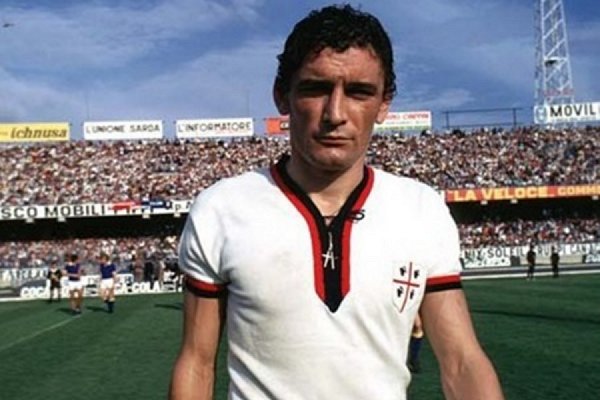
- Name: Silvio Piola
- Born: 29 September 1913, died 4 October 1996
- Position: Centre-Forward
- Jersey number: #9
- Youth career: Veloces 1925, Pro Vercelli
- Pro career (1929-1954): Pro Vercelli, Lazio, Torino, Juventus, Novara
- National team: Italy
The youngest player to ever score a hat-trick in Serie A, one of the toughest leagues in the world. He was only 17. Silvio Piola is a legend of the Italian soccer and has the status of a god in Pro Vercelli: a club that was able to win league titles over Juventus, Milan and Inter, once upon a time. Pro Vercelli’s stadium was named after him.
Piola was considered to be a modern and well-rounded player during his time, as he used his physical attributes, intelligence, and control to play with his back to goal, and lay off the ball for teammates in order to provide them with assists. His vision, work-rate, and technical ability, as well as his passing ability, made him a tactically versatile player who was capable of playing in several positions, and he was deployed on the wing, in midfield, or as a creative advanced playmaker or second striker on occasion.
He was part of the Italian squad that won the 1933–35 Central European International Cup and also a FIFA World Cup winner in 1938. He scored twice in that final, and was named the tournament’s second-best player. Piola is the only player to have the honour of being the all-time Serie A top scorer of three different teams (Pro Vercelli, Lazio and Novara) and is also the highest scoring Italian player in all competitions, with 364 goals (391 if his goals in the Divisione Nazionale and for the Italy B team are also included). Throughout his career, including friendlies, Piola scored 682 goals.
Overall, Piola was a real winner who would always aim at victory no matter how strong the opponents were.
Endorsers: Bok de Korver (1943), László Cseh (1937)
#42. Platini (France)
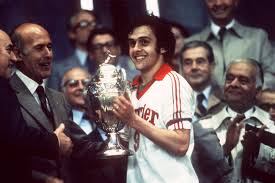
- Name: Michel Platini
- Born: 21 June 1955
- Position: Attacking Midfielder
- Jersey numbers: #10, #11, #15
- Youth career: AS Jœuf, Nancy
- Pro career (1972-1987): Nancy, Saint-Étienne, Juventus
- National team: France
What a same that this fine player, the definition of a playmaker, a real “maestro” on the field, retired at the age of 32. As a Juventus player, but he could have lingered for longer. Platini won the Ballon d’Or three times in a row, in 1983, 1984 and 1985, and came seventh in the FIFA Player of the Century vote. That shows a lot about his worth and recognition.
He was one of the finest passers in soccer history, as well as one of the best ever penalty kick and free kick specialists ever. A quick, versatile, elegant, and intelligent offensive midfield playmaker, with a unique ability to read the game and bend the ball from set pieces, Platini was renowned in particular for his ball control, technical ability, dribbling skills, creativity, range of passing, and vision, despite his lack of notable physical or athletic attributes. Apart from his midfield skill, the Frenchman was a prolific goalscorer, too (313 goals in 583 matches). His time with Saint Etienne and Juventus will forever be memorable. But, Platini will always be a legend and for the France national team: he led them to the UEFA Euros triumph in 1984 and the third place in the 1986 World Cup.
Russian forward Igor Belanov and Italian journalists Enrico De Santis, Luigi Corino considered Platini as the best player in history, while Giovanni Trapattoni said that he was the best player he ever coached.
Endorsers: Igor Belanov, Enrico De Santis, Luigi Corino
#43. Sastre (Argentina)
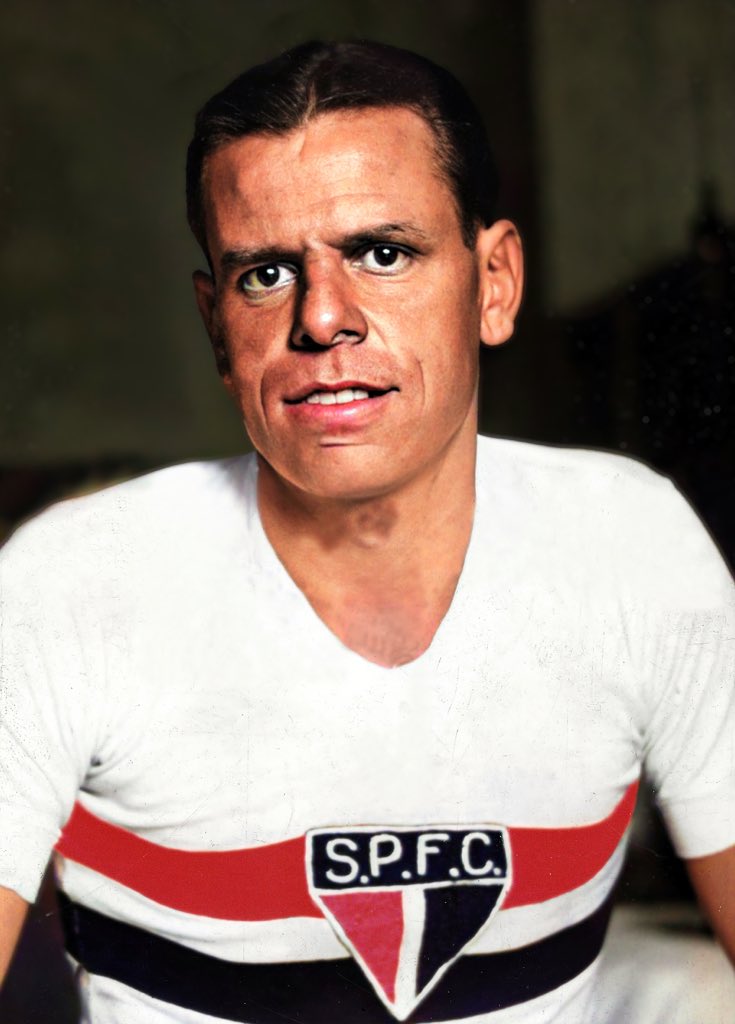
- Name: Antonio Sastre
- Born: 27 April 1911, died 23 November 1987
- Position: Midfielder, Right Half, Left Half
- Jersey number: #4
- Youth career: Progresista
- Pro career (1931-1947): Independiente Avellaneda, São Paulo, Gimnasia (LP)
- National team: Argentina
Sastre was an all-round midfielder who could play well almost anywhere on the pitch due to his intelligence and versatility. Nicknamed as “Sastrín”, he was renowned for his superb vision and amazing technical skills. He primarily performed a role similar to today’s playmaker, but he was a player who could play in any position if the team needed him to.
After a great career with Indepentiende and 112 goals in 340 appearances in 11 years with the club he moved to Brazil in 1942. With São Paulo, Sastre won three Paulista championships in 1943, 1945 and 1946 and was one of the first Argentinians to play in Brazil. His first months in Brazil were tough, getting a lot of pressure from the press, but he soon managed to become a fans’ favourite.
Sastre is also known as one of the first true playmakers of the pre-war era as well as one of the best ever by then and won 11 titles at club level, and 2 Copa Americas with the Argentina national team: 1937 and 1941. He is one of the 24 players inducted into the Argentine Football Association Hall of Fame.
Endorsers: Gerlado Jose de Almeida (1952), Nestor Pereira (1952)
#44. Van Basten (Netherlands)
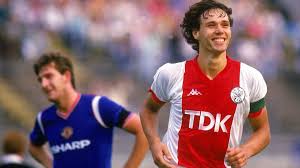
- Name: Marcel (Marco) van Basten
- Born: 31 October 1964
- Position: Centre-Forward
- Jersey numbers: #4, #6, #8, #9, #12, #14, #16
- Youth career: EDO, Utrecht, Elinkwijk
- Pro career (1981-1995): Ajax, AC Milan
- National team: Netherlands
The ultimate centre-forward. The highest paid player in the world in the early 1990s. What a shame we didn’t see more of him after that cursed for Van Basten (and Netherlands) Euros 1992. That was when he suffered a severe ankle injury that tragically cut short his career. After that injury, not only he didn’t play much, but when he did, he wasn’t the same player. In 1995, aged 31, he decided to call it a day. As an AC Milan player and when the “rossoneri” had become a dream team: Baggio, Weah, Futre had signed in the summer of 1995. However, his last match was in 1993, with Van Basten only 29 years old.
He was known for his close ball control, attacking intelligence, impeccable headers, and spectacular strikes and volleys, like the iconic one that he scored in the 1988 Euros final against Soviet Union. Van Basten was a fast, fine, opportunistic striker. He is regarded as one of the greatest and most complete strikers and players in the history of the sport, due to his prolific goalscoring and great skill set.
Van Basten was dubbed the “Swan Of Utrecht” for his elegance and intelligent attacking play, and was known for his penchant for scoring acrobatic goals. His height and strength allowed him to excel in the air, and his technical ability and agility saw him execute spectacular strikes throughout his career, such as volleys and bicycle kicks. He only played in one World Cup, the one hosted by the country he was living at the time, Italy.
In 2005, aged 41, he played in an exhibition match against legendary retired and active players. He was one of the best on the pitch. Despite his damaged ankle. About the day he decided to retire in 1995, Van Basten had said: “I will never forget it, it was an August day in Milanello. I was training alone and could not do the planned exercises. It had been a long time since I met my objectives and I was getting depressed. I decided there, alone, on the grass.“
Endorsers: Giovanni Cornacchini (2019), Arrigo Sacchi, Luigi Corino
#45. White (Scotland)
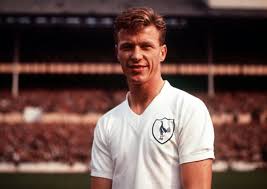
- Name: John White
- Born: 28 April 1937, died 21 July 1964
- Position: Inside Forward
- Jersey numbers: #7, #8, #10
- Pro career (1955-1964): Alloa Athletic, Falkirk, Tottenham Hotspur
- National team: Scotland
An incredible, but tragic player. In his just five season with Tottenham he helped them win the league title, the Cup Winners’ Cup and the FA Cup (the latter twice). Tottenham never got the same after White passed away – as an active player. They never won the league ever since.
John White had a silken first touch, an astute passing game and an ability to lose his marker that, combined with his slight frame and pale complexion, earned him the nickname ‘the Ghost”. Cliff Jones, his Spurs teammate, said of him: “He was a great talent. People ask me what he was like. I say that he was like Glenn Hoddle. But he was different to Glenn in some ways. Glenn was someone who you had to bring into a game, whereas John White would bring himself into a game. If you’re not in possession, get in position, that was John White. He was always available if you needed to pass to someone”.
The Scot played as a midfielder, mainly as an inside forward, but overall he was a team player. He was killed by a lightning strike at the age of 27. He was found crouched and scorched under a tree, how unlucky John White was. Tottenham and Scotland had lost one of the finest players of his generation.
Endorsers: R. Wylie (1965), George Dunbar (1965)
#46. Zico (Brazil)
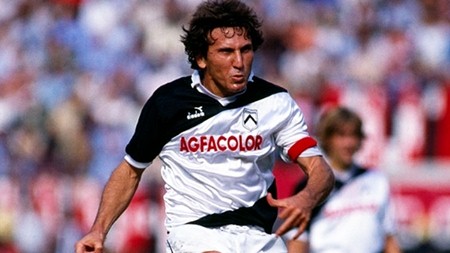
- Name: Arthur Antunes Coimbra
- Born: 3 March 1953
- Position: Attacking Midfielder, Forward
- Jersey numbers: #8, 10, #13
- Youth career: Flamengo
- Pro career (1971-1994): Flamengo, Udinese, Flamengo, Kashima Antlers
- National team: Brazil
The highest goalscoring attacking midfielder in the history of soccer. The player who scored the most free-kicks (101). The “White Pele”. According to Pele himself, Zico was the one who came closer to him. Underrated, for sure. A giant, mythical player, Flamengo and Kashima Antlers’ legend.
In total official and non-official games, he scored 826 goals, according to his own website. Zico played as an attacking midfielder, although he was also capable of playing in several other attacking and midfield positions, and was also deployed as a central midfielder, as a second striker or inside forward, or even as an outside forward. A diminutive playmaker, with a small, slender physique, although he was naturally right-footed, he was essentially able to shoot very well with both feet. Zico was known for his flair, speed, exceptional technique, ball control and dribbling skills, as well as his use of tricks and feints to beat opponents with the ball. Undoubtedly, one of the best dribblers in the history of the sport.
He played in Japan for three years and excelled. Zico has the status of a soccer god in the country of the Rising Sun where he went at the age of 38 and played until 41. Before, he had played for Flamengo for his whole career with a 2-year break in Italy and Udinese. He could have stayed longer in Serie A, but he didn’t want to. With 48 goals in 71 official appearances for Brazil, Zico is the fifth highest goalscorer for his national team, representing Brazil in the 1978, 1982 and 1986 World Cups. He is widely regarded as the greatest Brazilian never to win the World Cup.
Endorsers: Dejan Petkovic, Ronaldo Nazario (1999), Roberto Baggio


